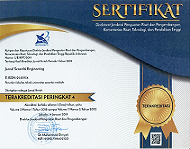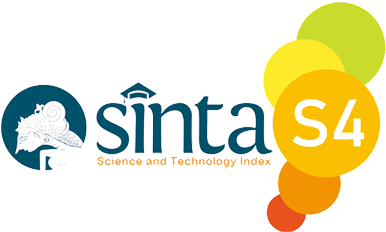Substitusi Lemak dari Crude Palm Oil dalam Pembuatan Keju Vegan Susu Kedelai dengan Fermentasi Lactobacillus bulgaricus dan Streptococcus lactis
Keywords:
Keju Vegan, Minyak Kelapa Sawit, Substitusi Lemak Susu, Kacang Kedelai, Susu kedelaiAbstract
Indonesia is one of the world's largest producers of palm oil. However, most palm oil products are still limited to crude form and are exported without further processing. Therefore, it is essential to encourage public interest in the downstream processing of Crude Palm Oil (CPO) to increase its added value and optimize its contribution to the national economy. One potential application of CPO in the food industry is as a substitute for natural oils and fats, such as milk fat, in the production of vegan cheese. The research method employed several stages: the degumming of CPO, the hydrolysis of CPO fatty acids, and the production of vegan cheese from soy milk with the addition of CPO fatty acids. The soy milk to CPO fatty acid ratios used were 9:1, 8:2, and 7:3. The fermentation process involved inoculation with Lactic Acid Bacteria (LAB), Lactobacillus bulgaricus and Streptococcus lactis at a concentration of 15%, with incubation periods of 6, 12, and 18 hours. The results showed that CPO fatty acids can effectively replace milk fat in the production of soy milk-based vegan cheese. The resulting product exhibited the following characteristics: moisture content from 23,16 – 36,28%, ash content from 0,44 – 0,94%, protein content from 10,03 - 17,87%, and a stable pH of 5, all of which meet the requirements of the Indonesian National Standard (SNI) for processed cheese.
References
[1] S. I. BPS Indonesia, “Catalog : 1101001,” Stat. Indones. 2023, vol. 1101001, hal. 790, 2023, [Daring]. Tersedia pada: https://www.bps.go.id/publication/2020/04/29/e9011b3155d45d70823c141f/statistik-indonesia-2020.html
[2] Gapki (Gabungan Pengusaha Kelapa Sawit Indonesia), "Palm Oil Performance : Production Drops, Local Consumption Keeps Rising," 2024, Diakses pada 24 Januari 2025 dari https://gapki.id/en/news/2023/10/28/palm-oil-performance-in-august-2023-production-drops-local-consumption-keeps-rising/.
[3] S. Sujadi, H. A. Hasibuan, H. Y. Rahmadi, dan A. R. Purba, "Komposisi Asam Lemak dan Bilangan IOD Minyak dari Sembilan Varietas Kelapa Sawit DxP,” J. Penelit. Kelapa Sawit, vol. 24, no. 1, hal. 1–11, 2016, doi: 10.22302/iopri.jur.jpks.v24i1.1.
[4] H. A. Hasibuan, “Kajian Mutu Dan Karakteristik Minyak Sawit Indonesia Serta Produk Fraksinasinya,” J. Stand., vol. 14, no. 1, hal. 13, 2012, doi: 10.31153/js.v14i1.51.
[5] BPDPKS, "Produk Pangan Olahan Kelapa Sawit," 2024, Diakses pada 25 Januari 2025 dari https://www.bpdp.or.id/Produk-Pangan-Olahan-Kelapa-Sawit.
[6] P. E. Remantari, “Inovasi rasa pada keju vegetarian: Innovation in vegetarian cheese,” J. Ilm. Pariwisata dan Bisnis, vol. 1, no. 4, hal. 1030–1048, 2022.
[7] M. Alveanita, "Susu Sapi Vs Susu Kedelai," 2016, [internet Tersedia pada : http://www.pekalongankab.go.id/informasi/artikel/pertanian/8222-susu-sapi-vs-susu kedelai.html ].
[8] I. Romero-Sánchez, I. Alonso-Núñez, E. Gracia-Lor, dan Y. Madrid-Albarrán, “Analysis and evaluation of in vitro bioaccessibility of aflatoxins B1, B2, G1 and G2 in plant-based milks,” Food Chem., vol. 460, no. February, 2024, doi: 10.1016/j.foodchem.2024.140538.
[9] K. Syamsu dan K. Elsahida, “Pembuatan Keju Nabati Dari Kedelai Menggunakan Bakteri Asam Laktat Yang Diisolasi Dari Dadih,” J. Teknol. Ind. Pertan., vol. 28, no. 2, hal. 154–161, 2018, doi: 10.24961/j.tek.ind.pert.2018.28.2.154.
[10] Ciptasari, Riska, dan Nurrahman, "Sifat Fisik, Sifat Organoleptik Dan Aktivitas Antioksidan Susu Bubuk Kedelai Hitam Berdasarkan Konsentrasi Tween 80," Jurnal Pangan Dan Gizi,10(1), 45–59, 2020, https://doi.org/10.26714/jpg.10.1.2020.49-63.
[11] Z. Lyu, G. Sala, dan E. Scholten, “Melting properties of vegan cheese: Effect of emulsion and protein addition on the thermal behaviour of starch gels,” Food Hydrocoll., vol. 144, no. June, hal. 108917, 2023, doi: 10.1016/j.foodhyd.2023.108917.
[12] A. Arsyi Anggraini dan T. Ardyati, “Pengaruh Kombinasi Starter Bakteri Asam Laktat (BAL) pada Pembuatan Keju Kedelai (Soy Cheese),” Biotropika - J. Trop. Biol., vol. 5, no. 3, hal. 83–85, 2017, doi: 10.21776/ub.biotropika.2017.005.03.4.
[13] Puspawati, Ni Nyoman, and I. Made Sugitha. "Pengaruh perlakuan 3 jenis bakteri asam laktat dan kombinasinya terhadap karakteristik keju kedelai." Jurnal Ilmu Dan Teknologi Pangan (ITEPA) 9.4 (2020): 412-425.
[14] A. Abubakar, “Mutu Keju Putih Rendah Lemak Diproduksi Dengan Bahan Baku Susu Modifikasi,” Bul. Peternak., vol. 40, no. 2, hal. 144, 2016, doi: 10.21059/buletinpeternak.v40i2.9085.
[15] D. T. Daulima, A. Andriyani, P. N. Mustofa, dan S. A. Liputo, “Cheese Analog Basis Susu Jagung Manis dan Susu Kedelai Sebagai Keju Rendah Lemak,” J. Agritechnology Food Process., vol. 1, no. 2, hal. 61, 2021, doi: 10.31764/jafp.v1i2.6684.
Downloads
Published
Issue
Section
License
Copyright (c) 2025 Nadya Septiani, Martha Aznury, Linda Ekawati (Author)

This work is licensed under a Creative Commons Attribution 4.0 International License.












